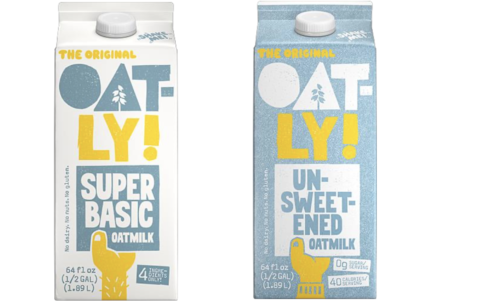Amid its ongoing shift to an asset-light production model, Oatly reported net sales rose 2.5% to $187.6 million in Q3 during its earnings report today. Despite mixed results across its three segments, the Swedish oat milk maker announced it would modify its 2023 guidance, after seeing a diversification in its Americas food service business and “strategic reset” in Asia.
For the 2023 fiscal year, the company is now forecasting constant currency revenue growth to be on the low end of the projected range of 7% to 12%, and fourth quarter gross margins to come in at the mid-20s, down from prior expectations of high 20s. Executives do believe the company is still on track to achieve profitable growth in 2024.
“Our [Q3] profitability exceeded our internal expectations and improved sequentially in each segment. We are clearly starting to see the positive impact of the bold actions we have been taking,” said CEO Jean-Cristophe Flatin.
A Geographic Overview:
- Revenue was driven primarily by Europe, the Middle East and Africa (EMEA) sales, which grew 23.2% to $101.8 million in the quarter and represented 54% of the company’s revenue.
- The EMEA growth was a direct result of price increases introduced at the beginning of the year as well as solid volume growth in oat drinks.
- Meanwhile, revenue in the Americas slid 3.6% to $58.5 million.
- In Asia, the oat milk maker also saw sales drop, falling 31.2% to $27.3 million. The segment’s decline was driven by Oatly’s decision to refocus into the foodservice channel, resulting in the discontinuation of certain lower-margin products across the retail and ecommerce channels.
What’s the Picture for the Americas?
In January, the company began its transition to an asset-light supply chain model after closing a $72 million deal with Ya YA Foods Corp., a Toronto-based co-packer. Under the deal, Oatly will continue producing its proprietary oat-base at both its Ogden, Utah and Fort Worth, Texas facilities, while Ya YA will handle manufacturing and packaging for finished liquid Oatly products at the plants.
During the call with analysts, Flatin said the company would double down on this strategy, discontinuing the construction of new manufacturing plants in EMEA and the Americas. Existing manufacturing capabilities, which already can produce 385 million more liters than current volume sales, coupled with improvements to its manufacturing network utilization, efficiency and reliability, are expected to support volume growth over the next several years.
As a result of this business change, CapEx is forecasted to drop to below $75 million for 2023 and 2024, a significant improvement from the prior guidance of $110 to $130 million. Already, co-packer consolidation in the Americas has driven down the cost of goods per liter by 10% from quarter one to quarter three, driven largely, executives said, by the transaction with Ya YA Foods earlier this year.
Another positive sign, the executives reported, is that Oatly is again gaining retail market share in the Americas, reporting its value share of the chilled oatmilk category was at 24% over the last four weeks and 23% over the last 52 weeks. Oatly has continued to see distribution growth in the Americas, up 18% year-over-year and with an ACV of 39%. As part of fall and winter resets, the company will add over 1,000 new doors in Walmart, Meijer and Stop and Shops, while also picking up two more Costco regions.
“While the category growth rate has not been as strong as we would like, we firmly believe that consumers will continue to shift to oat milk over time,” COO Daniel Ordonez told analysts. “So, we are focused on controlling the controllables and ensuring that we are building our business to achieve long-term profitable growth.”
To compete in the wider alt-milk set, Oatly is launching two new oatmilks in the Americas: one with only four ingredients and a second zero-sugar SKU that has a calorie count closer to that of almond milk. Four coffee creamers are also on the way.
In foodservice, which accounted for 45% of Oatly’s revenue in the Americas for the last quarter, business revenue declined 6% in the quarter. However, if you exclude Oatly’s largest customer in the channel, foodservice revenue actually grew 10%. Despite this disparity, Ordonez said Oatly has no plans to “walk away from any contract and any customer.”
“We’re just rebalancing our out-of-home and foodservice channel sales,” he told investors. “There is ample opportunity to grow to both channels, as you see our recent distribution gains in the U.S. with some early signs of market data improvement. And the same thing goes for out-of-home and foodservice, ample growth opportunities, it’s just the rebalancing of the equation between both to make sure that we’re true to our quality of growth, and that Oatly becomes a much better and stronger business before it becomes a bigger business.”
While executives spoke of a more positive outlook, one analyst, who said he was playing “devil’s advocate,” asked if the manufacturing changes were not, as they were positioned, “a doubling down on the asset-light production model” but rather a result of declining sales in the Americas and declining volumes year-over-year.
“I have a very strong pushback for you, which is that there is no demand issue for us. What drives demand is our ability to fully deploy our playbook,” Flatin said. “Oatly is the key driver of category growth, especially when we combine sustained capacity, distribution gains, and ground-building investments.”

